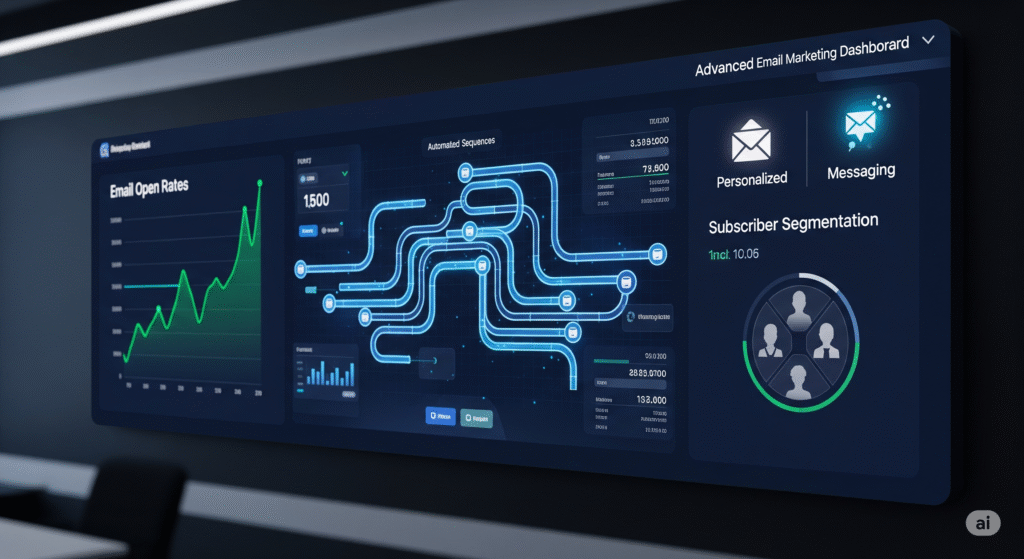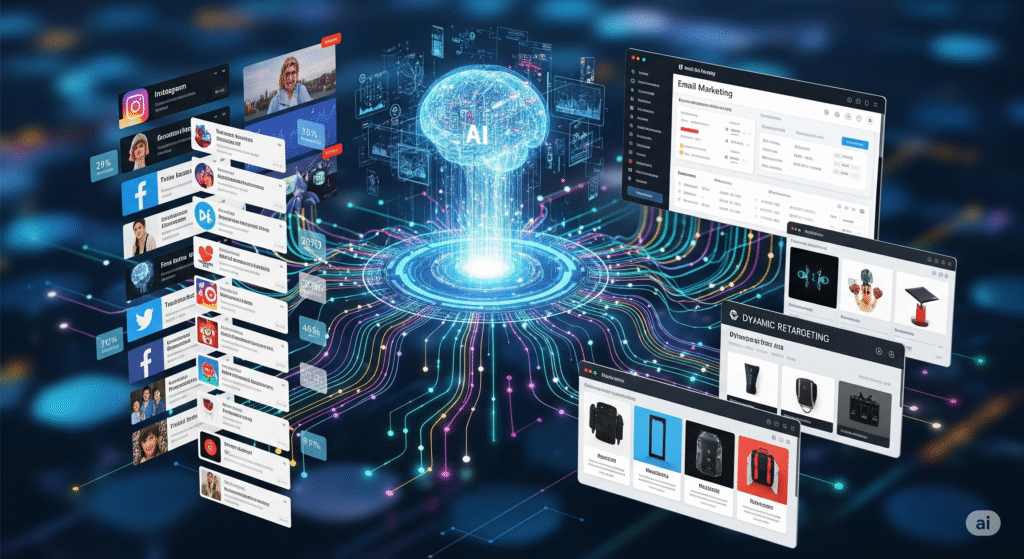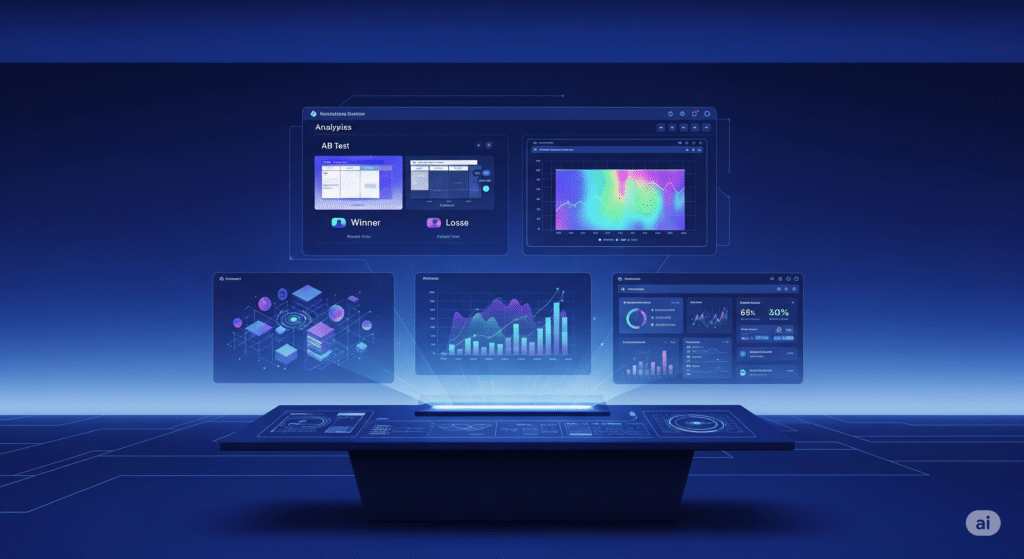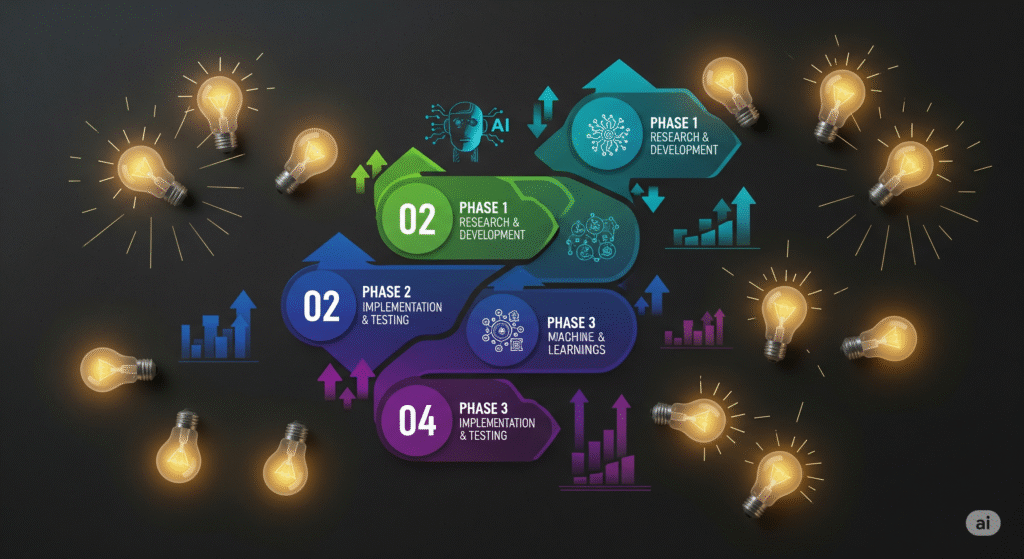Published by Mithun Srivastava | AutomateToProfit.com
When Sarah Martinez first contacted me in January 2024, she was earning approximately $500 per month from her affiliate marketing efforts despite working 60+ hours per week creating content, managing social media, and manually responding to emails. She had been struggling for over two years to build a sustainable affiliate business in the productivity and business tools niche, and was seriously considering giving up on her entrepreneurial dreams to return to her corporate marketing job.

Eighteen months later, Sarah’s affiliate business generates over $47,000 per month in consistent revenue while requiring only 15-20 hours of her weekly attention. Her transformation wasn’t the result of a lucky break or viral content—it was the systematic implementation of AI-powered automation strategies that transformed every aspect of her business from content creation and audience building to conversion optimization and customer relationship management.
What makes Sarah’s story particularly compelling isn’t just the dramatic revenue increase, but how the automation systems enabled her to build a business that truly serves her lifestyle goals. She now travels extensively while her automated systems continue generating income, has built a team of virtual assistants who handle the remaining manual tasks, and has created multiple passive income streams that provide financial security and freedom.
The strategies that transformed Sarah’s business aren’t unique to her situation or niche—they represent a systematic approach to affiliate marketing automation that can be adapted to virtually any niche or business model. The key insights from her transformation provide a roadmap that other affiliate marketers can follow to achieve similar results, regardless of their starting point or current level of success.
This case study documents the specific strategies, tools, and implementation steps that drove Sarah’s transformation, including the challenges she encountered, the solutions that worked, and the lessons learned that can help other affiliate marketers avoid common pitfalls while accelerating their own success. Every detail is based on real data from Sarah’s business, including revenue figures, conversion rates, traffic statistics, and time investment tracking that provide concrete evidence of what’s possible with systematic AI automation implementation.
The Starting Point: A Struggling Affiliate Marketer’s Reality
Sarah’s situation in early 2024 represented the challenges that most affiliate marketers face when trying to build sustainable businesses using traditional manual methods. Despite having solid marketing knowledge from her corporate background and genuine passion for helping small business owners improve their productivity, she was trapped in a cycle of constant content creation and manual outreach that consumed all her time while generating minimal income.
Her typical week involved creating 5-7 blog posts, managing social media accounts across four platforms, manually responding to dozens of emails and comments, researching and writing product reviews, and attempting to build relationships with potential customers through individual outreach. This exhausting schedule left little time for strategic thinking, business development, or the personal life she had hoped to achieve through entrepreneurship.
The financial reality was equally challenging. Her $500 monthly affiliate income barely covered her business expenses, let alone provided the financial freedom she sought. Her conversion rates were consistently below industry averages, with email open rates around 18%, click-through rates below 2%, and affiliate conversion rates under 1%. Despite having built an email list of approximately 3,000 subscribers over two years, she was generating less than $0.17 per subscriber per month—far below the $1-3 per subscriber that successful affiliate marketers typically achieve.
The content creation process was particularly problematic. Sarah spent 8-10 hours writing each blog post, often struggling with writer’s block and spending excessive time on research that could have been streamlined with better systems. Her social media presence was inconsistent due to time constraints, and she frequently missed opportunities to engage with her audience when they were most active online.
Perhaps most frustrating was the lack of scalability in her approach. Every new subscriber required the same manual attention, every piece of content demanded the same time investment, and every potential customer interaction needed her personal involvement. She had built a business that required her constant presence rather than systems that could operate independently and scale beyond her personal time limitations.
The psychological toll was significant. Sarah reported feeling overwhelmed, frustrated, and increasingly doubtful about her ability to succeed as an entrepreneur. She was working longer hours than her previous corporate job while earning a fraction of her former salary, and the stress was affecting her health, relationships, and overall quality of life.
The Transformation Strategy: Systematic AI Implementation
The transformation of Sarah’s business began with a comprehensive audit of her existing processes and the development of a systematic automation strategy that would address her most significant challenges while building scalable systems for long-term growth. Rather than attempting to automate everything at once, we developed a phased approach that would deliver immediate improvements while building the foundation for more sophisticated automation.
Phase 1: Content Creation Revolution (Months 1-2)
The first phase focused on revolutionizing Sarah’s content creation process using AI-powered research and optimization tools. This phase was critical because content creation consumed the largest portion of her time while being essential for her affiliate marketing success.
We implemented ChatGPT Plus as her primary research and ideation tool, but the key was developing sophisticated prompting strategies that went far beyond basic content generation. Sarah learned to use ChatGPT for comprehensive market research, competitor analysis, and audience insight development that previously required hours of manual research.
The content creation workflow transformation was dramatic. Instead of spending 8-10 hours per blog post, Sarah’s new AI-assisted process reduced this to 3-4 hours while actually improving content quality and comprehensiveness. The AI tools enabled her to research topics more thoroughly, identify content gaps that competitors were missing, and develop more strategic content that better served her audience’s needs.
Surfer SEO was integrated into her content optimization process, providing data-driven insights that improved her search engine rankings significantly. Within two months, her organic traffic increased by 180% as her AI-optimized content began ranking for competitive keywords that her previous content couldn’t capture.
The content calendar development process was also automated using AI analysis of seasonal trends, industry events, and audience behavior patterns. This strategic approach to content planning enabled Sarah to create content that aligned with her audience’s changing needs throughout the year while supporting her affiliate promotion schedule.
Phase 2: Email Marketing Automation (Months 2-4)

The second phase focused on transforming Sarah’s email marketing from manual, generic broadcasts into sophisticated behavioral automation that provided personalized experiences for each subscriber. This transformation was crucial for improving her conversion rates and building stronger relationships with her audience.
We migrated Sarah’s email list from her basic email platform to ActiveCampaign, which provided the advanced automation capabilities needed for behavioral segmentation and personalized messaging. The migration process included comprehensive list cleaning and segmentation based on subscriber behavior and demonstrated interests.
The welcome series was completely redesigned as a comprehensive educational experience that provided immediate value while naturally introducing Sarah’s affiliate recommendations. Instead of a simple welcome email, new subscribers received a 7-email sequence that addressed their specific challenges while positioning Sarah as a trusted advisor and expert in productivity optimization.
Behavioral triggers were implemented throughout the email system to automatically segment subscribers based on their actions and interests. Subscribers who clicked on links about specific topics were automatically tagged and received additional content about those topics, while those who showed high engagement received exclusive offers and premium content.
The product recommendation sequences were redesigned to focus on education and value rather than direct promotion. Each affiliate product was introduced through comprehensive case studies that demonstrated real-world applications and results, making the recommendations feel helpful rather than sales-focused.
The results were immediate and significant. Email open rates increased from 18% to 34% within the first month of implementation, while click-through rates improved from 2% to 8%. Most importantly, affiliate conversion rates increased from under 1% to over 4%, directly contributing to Sarah’s revenue growth.
Phase 3: Multi-Channel Integration (Months 4-6)

The third phase expanded Sarah’s automation beyond email to create comprehensive multi-channel experiences that reinforced her messaging across multiple touchpoints. This integration was essential for building stronger relationships with her audience while maximizing the impact of her content and recommendations.
Social media automation was implemented using Hootsuite’s AI-powered scheduling and content optimization features. Instead of manually posting content throughout the day, Sarah’s social media presence became consistent and strategic, with content automatically optimized for each platform’s unique characteristics and audience behavior patterns.
The social media content was strategically integrated with her email automation to create cohesive experiences across channels. Subscribers who engaged with specific email topics would see related content in their social media feeds, while social media followers were encouraged to join her email list through platform-specific lead magnets and content upgrades.
Retargeting campaigns were implemented across Facebook and Google to reconnect with website visitors who hadn’t yet joined her email list or made affiliate purchases. These campaigns used personalized messaging based on the specific pages visitors had viewed, creating relevant and timely touchpoints that improved conversion rates.
Content marketing integration connected Sarah’s blog content with her automation systems to create comprehensive educational experiences. Blog readers could access related email courses, exclusive resources, and personalized recommendations based on their demonstrated interests and engagement patterns.
The webinar automation system was perhaps the most impactful addition during this phase. Sarah created an evergreen webinar that provided comprehensive training on productivity optimization while naturally incorporating her affiliate recommendations. This webinar operated automatically, providing high-value educational experiences that converted at significantly higher rates than her other marketing channels.
Phase 4: Advanced Optimization and Scaling (Months 6-12)

The fourth phase focused on systematic optimization and scaling of Sarah’s automated systems to maximize performance while expanding her reach and revenue potential. This phase involved comprehensive analytics implementation, systematic testing, and strategic expansion of successful elements.
Advanced analytics were implemented to track prospect behavior across all touchpoints, providing detailed insights into the customer journey from initial awareness through final purchase and beyond. This comprehensive tracking enabled data-driven optimization decisions and revealed opportunities for improvement that weren’t apparent from surface-level metrics.
A/B testing frameworks were established to continuously optimize every aspect of Sarah’s marketing funnel. Email subject lines, landing page headlines, call-to-action buttons, and content formats were systematically tested to identify the approaches that generated the highest engagement and conversion rates.
The lead magnet strategy was expanded to include multiple entry points that appealed to different audience segments and interests. Instead of a single lead magnet, Sarah developed a library of resources that attracted prospects with varying needs and experience levels, enabling more targeted automation sequences.
Traffic scaling strategies were implemented to systematically increase the number of qualified prospects entering Sarah’s automated systems. This included SEO optimization for long-tail keywords, strategic guest posting, podcast appearances, and paid advertising campaigns that maintained profitability while scaling reach.
Revenue optimization focused on maximizing the value extracted from each prospect through strategic upselling, cross-selling, and premium offering development. Sarah created higher-priced coaching programs and done-for-you services that provided exceptional value while significantly increasing her average customer value.
The Results: Quantified Transformation
The results of Sarah’s AI automation implementation were both dramatic and sustainable, representing a complete transformation of her business model from manual, time-intensive operations to scalable, automated systems that continued to improve over time.
Revenue Growth and Financial Transformation
The most visible result was the dramatic increase in Sarah’s monthly affiliate revenue from $500 to over $47,000 within 18 months. This 9,400% increase wasn’t the result of a single breakthrough but rather the compound effect of systematic improvements across every aspect of her business.
The revenue growth followed a predictable pattern that reflected the phased implementation approach. Month 3 saw her first significant increase to $1,200 monthly revenue as her content creation improvements began driving more traffic and her email automation started converting better. By month 6, she had reached $5,800 monthly revenue as her multi-channel integration created more touchpoints and conversion opportunities.
The most dramatic growth occurred between months 9-15 as her optimization efforts and scaling strategies reached full effectiveness. Monthly revenue grew from $12,000 to $35,000 during this period, with the final push to $47,000 occurring as her premium offerings and advanced automation sequences reached maturity.
Perhaps more importantly than the absolute revenue numbers was the improvement in revenue per subscriber, which increased from $0.17 per month to $3.20 per month. This improvement reflected the enhanced value she was providing to her audience and the more strategic approach to affiliate recommendations that her automation enabled.
The revenue diversification was equally impressive. Instead of relying solely on affiliate commissions, Sarah’s business now includes multiple income streams including affiliate marketing (60% of revenue), coaching programs (25%), done-for-you services (10%), and digital product sales (5%). This diversification provides financial stability while reducing dependence on any single revenue source.
Operational Efficiency and Time Freedom

The operational transformation was as significant as the financial results. Sarah’s weekly time investment decreased from 60+ hours to 15-20 hours while her business became significantly more effective and profitable. This efficiency improvement enabled her to focus on high-value strategic activities while her automated systems handled routine operations.
Content creation time decreased from 8-10 hours per blog post to 3-4 hours while content quality and performance improved significantly. The AI-assisted research and optimization process enabled Sarah to create more comprehensive, valuable content that ranked better in search engines and generated higher engagement rates.
Email marketing, which previously required 10-15 hours per week for list management, content creation, and manual responses, was reduced to 2-3 hours per week for strategy and optimization while the automated systems handled subscriber communication and segmentation.
Social media management was reduced from 15-20 hours per week to less than 5 hours per week while maintaining more consistent presence and higher engagement rates. The automation tools enabled strategic posting and engagement while freeing Sarah to focus on relationship building and content creation.
Customer service and prospect communication, which previously consumed 20+ hours per week, was largely automated through sophisticated email sequences, chatbot integration, and self-service resources. Sarah now spends less than 5 hours per week on direct customer communication while providing better service through her automated systems.
Performance Metrics and Conversion Improvements
The performance improvements across all key metrics demonstrated the effectiveness of the AI automation implementation. Email open rates increased from 18% to 34%, reflecting improved subject line optimization and better audience segmentation. Click-through rates improved from 2% to 8% as a result of more relevant content and strategic call-to-action placement.
Affiliate conversion rates increased from under 1% to over 4%, representing a 400%+ improvement that directly contributed to revenue growth. This improvement resulted from better product-market fit, more strategic recommendation timing, and enhanced trust building through valuable content and authentic recommendations.
Website conversion rates improved from 1.2% to 4.8% as landing page optimization, lead magnet improvements, and user experience enhancements made it easier for visitors to take desired actions. The comprehensive analytics implementation enabled continuous optimization based on real user behavior data.
Social media engagement rates increased by 250% as automated posting optimization and strategic content planning improved the relevance and timing of Sarah’s social media presence. This increased engagement translated into higher website traffic and email list growth.
Organic search traffic increased by 340% within 12 months as AI-optimized content began ranking for competitive keywords and long-tail search terms. This organic growth provided sustainable traffic that didn’t require ongoing advertising investment while attracting highly qualified prospects.
Lifestyle and Personal Transformation
Beyond the business metrics, Sarah’s personal transformation was equally significant. The time freedom enabled by automation allowed her to travel extensively while her business continued operating effectively. She spent three months traveling through Europe while her automated systems maintained consistent revenue and customer service.
The reduced stress and improved work-life balance had significant positive impacts on Sarah’s health, relationships, and overall quality of life. She reported sleeping better, exercising regularly, and having time for hobbies and relationships that had been neglected during her manual business operations.
The financial security provided by consistent, growing revenue enabled Sarah to make long-term plans and investments that weren’t possible when her income was unpredictable and minimal. She purchased a home, invested in retirement accounts, and built an emergency fund that provided peace of mind and financial stability.
Perhaps most importantly, Sarah regained confidence in her entrepreneurial abilities and began helping other affiliate marketers implement similar automation strategies. This evolution from struggling marketer to successful entrepreneur and mentor represented a complete transformation of her professional identity and future prospects.
Key Lessons and Implementation Insights
Sarah’s transformation provides valuable lessons and insights that can guide other affiliate marketers in implementing similar automation strategies. These lessons were learned through real-world application and represent practical wisdom that can help others avoid common pitfalls while accelerating their own success.
The Importance of Systematic Implementation

One of the most critical lessons from Sarah’s transformation was the importance of systematic, phased implementation rather than attempting to automate everything simultaneously. The temptation to implement all available tools and strategies immediately was strong, but the phased approach enabled proper testing, optimization, and skill development at each stage.
The systematic approach also enabled Sarah to measure the impact of each implementation phase, providing clear evidence of what was working and what needed adjustment. This data-driven approach to automation prevented wasted effort on ineffective strategies while enabling rapid scaling of successful elements.
Each phase built upon the foundation established in previous phases, creating compound effects that amplified the overall transformation. The content creation improvements in phase one enhanced the effectiveness of email automation in phase two, which in turn improved the performance of multi-channel integration in phase three.
The systematic approach also prevented overwhelm and maintained focus on execution rather than constant strategy changes. By committing to each phase for specific time periods, Sarah avoided the common trap of constantly switching tools and strategies before giving them adequate time to show results.
The Critical Role of Audience Understanding
Sarah’s success was fundamentally built on deep understanding of her audience’s needs, challenges, and decision-making processes. The AI tools amplified this understanding but couldn’t replace the need for genuine empathy and insight into her audience’s situation.
The most effective automation strategies were those that felt personal and relevant to individual subscribers, which required comprehensive audience research and segmentation. The behavioral triggers and personalized content that drove Sarah’s conversion improvements were based on detailed understanding of how different audience segments preferred to receive information and make purchasing decisions.
The audience research process was ongoing rather than a one-time activity. Sarah continuously gathered feedback through surveys, direct communication, and behavioral analysis to refine her understanding and improve her automation strategies. This continuous learning approach enabled her systems to become more effective over time.
The authenticity of Sarah’s communication remained central to her success even as automation scaled her reach. The AI tools enabled her to maintain her personal voice and authentic recommendations while operating at much larger scale than manual methods would allow.
The Power of Value-First Automation
The most successful elements of Sarah’s automation strategy were those that prioritized providing value to her audience rather than maximizing short-term conversions. The educational email sequences, comprehensive content resources, and helpful product recommendations built trust and authority that enabled higher conversion rates over time.
The value-first approach also created sustainable competitive advantages that were difficult for competitors to replicate. While competitors focused on promotional messaging and direct sales tactics, Sarah’s value-focused automation built deeper relationships that resulted in higher customer lifetime value and more referrals.
The automation systems that provided the most value were those that solved real problems for Sarah’s audience while naturally leading toward affiliate recommendations. The productivity optimization strategies, tool implementation guides, and workflow templates provided immediate value while positioning her affiliate recommendations as logical next steps.
The long-term perspective was crucial for maximizing the effectiveness of value-first automation. While promotional approaches might generate faster initial results, the relationship-building approach created sustainable revenue streams that continued growing over time.
The Necessity of Continuous Optimization
Sarah’s transformation wasn’t the result of perfect initial implementation but rather continuous optimization based on performance data and audience feedback. The most successful automation elements were those that were systematically tested and refined over time.
The optimization process required comprehensive analytics and tracking to identify improvement opportunities that weren’t obvious from surface-level metrics. The behavioral analysis, conversion tracking, and customer journey mapping provided insights that guided strategic optimization decisions.
The testing frameworks enabled systematic improvement without disrupting successful elements of the automation systems. By testing individual components while maintaining overall system integrity, Sarah could optimize performance without risking the revenue and relationships she had built.
The optimization mindset was as important as the specific tools and strategies. Sarah approached her automation systems as continuously evolving assets that could always be improved rather than static implementations that were either successful or unsuccessful.
The Integration Advantage
The most significant performance improvements came from integrating multiple automation tools and strategies rather than implementing them in isolation. The compound effects of integrated systems provided advantages that exceeded the sum of individual components.
The integration approach required careful planning and systematic implementation to ensure that different tools and strategies reinforced each other rather than creating conflicts or confusion. The customer journey mapping and touchpoint analysis were crucial for creating cohesive experiences across multiple channels and platforms.
The data integration was particularly important for enabling sophisticated personalization and behavioral triggers. By connecting behavioral data across email, website, and social media touchpoints, Sarah could create automation that responded to comprehensive user behavior rather than isolated actions.
The integration approach also provided redundancy and multiple conversion opportunities that improved overall system resilience. If prospects didn’t convert through one channel or touchpoint, the integrated system provided alternative paths to engagement and conversion.
Replicating Sarah’s Success: Your Implementation Roadmap
Sarah’s transformation provides a proven roadmap that other affiliate marketers can adapt to their specific situations and niches. While the exact tools and strategies may vary based on individual circumstances, the fundamental principles and implementation approach can be applied across different business models and markets.
Assessment and Foundation Building
The first step in replicating Sarah’s success is conducting a comprehensive assessment of your current situation, including revenue, time investment, conversion rates, and operational efficiency. This baseline assessment provides the foundation for measuring improvement and identifying the areas with the greatest optimization potential.
The audience research and avatar development process should be thorough and ongoing, using both AI-powered analysis tools and direct feedback from your existing audience. Understanding your audience’s specific challenges, preferences, and decision-making processes is crucial for developing automation that feels relevant and valuable.
The tool selection process should prioritize integration capabilities and scalability rather than just individual features. Choose tools that can grow with your business and integrate effectively with other components of your automation system.
The content audit and optimization process should identify your highest-performing existing content while revealing gaps and opportunities for improvement. This analysis provides the foundation for developing content strategies that support your automation goals.
Phased Implementation Strategy
The phased implementation approach should be adapted to your specific situation while maintaining the systematic progression that enabled Sarah’s success. Start with the areas that consume the most time or have the greatest impact on your revenue and conversion rates.
Phase one should focus on the foundational elements that support all other automation efforts. This typically includes content creation optimization, basic email automation setup, and analytics implementation that provides the data needed for future optimization.
Phase two should expand your automation capabilities while building on the foundation established in phase one. This often includes advanced email segmentation, behavioral triggers, and multi-channel integration that creates more comprehensive customer experiences.
Phase three should focus on optimization and scaling of your automated systems through systematic testing, performance analysis, and strategic expansion. This phase enables you to maximize the effectiveness of your automation while scaling your reach and revenue.
Measurement and Optimization Framework
The measurement and optimization framework should track both leading indicators (like email open rates and website traffic) and lagging indicators (like revenue and customer lifetime value) to provide comprehensive insights into system performance.
The testing protocols should prioritize high-impact optimization opportunities while maintaining statistical rigor to ensure reliable results. Focus on testing elements that affect large numbers of prospects or have significant impact on conversion rates.
The optimization schedule should balance continuous improvement with system stability, avoiding too many simultaneous changes that make it difficult to identify what’s driving performance improvements.
The feedback collection and analysis process should include both quantitative data from your analytics systems and qualitative feedback from your audience through surveys, direct communication, and behavioral observation.
Scaling and Advanced Strategies
The scaling strategies should focus on sustainable growth that maintains or improves conversion rates rather than just increasing traffic volume. Quality prospects who are likely to engage with your content and purchase your recommendations are more valuable than large numbers of unqualified visitors.
The advanced automation strategies should be implemented only after mastering the foundational elements. Sophisticated personalization, predictive analytics, and AI-powered optimization require solid foundations to be effective.
The team building and delegation strategies should focus on systematizing and documenting your processes so that others can maintain and improve your automation systems. This enables you to focus on strategy and growth while others handle operational details.
The diversification strategies should expand your revenue streams and reduce dependence on any single traffic source or affiliate program. Multiple income streams provide stability while creating opportunities for cross-promotion and customer lifetime value optimization.
The Future of AI-Powered Affiliate Marketing

Sarah’s transformation represents just the beginning of what’s possible with AI-powered affiliate marketing automation. The tools and strategies that enabled her success are continuously evolving, with new capabilities and opportunities emerging regularly.
The trend toward more sophisticated personalization and behavioral analysis will enable even more targeted and effective automation strategies. Machine learning algorithms will become better at predicting customer behavior and optimizing conversion paths automatically.
The integration of voice technology, chatbot automation, and augmented reality will create new touchpoints and engagement opportunities that expand the possibilities for affiliate marketing automation.
The democratization of advanced AI tools will enable individual affiliate marketers to access capabilities that were previously available only to large corporations with significant technology budgets.
The key to future success will be maintaining focus on providing genuine value to your audience while leveraging technology to scale your impact and efficiency. The marketers who combine authentic relationship building with sophisticated automation will continue to achieve the most sustainable and significant results.
Sarah’s story demonstrates that dramatic business transformation is possible for affiliate marketers who are willing to embrace AI automation systematically and strategically. The tools and strategies exist today to replicate her success, and the competitive advantages available to early adopters will only increase as automation becomes more sophisticated and accessible.
Ready to begin your own transformation? Start by assessing your current situation and identifying the automation opportunities that could have the biggest impact on your affiliate marketing business. Use our interactive assessment tool to create a personalized automation roadmap based on your specific goals and challenges. Begin your transformation and discover how AI automation can revolutionize your affiliate marketing success.
